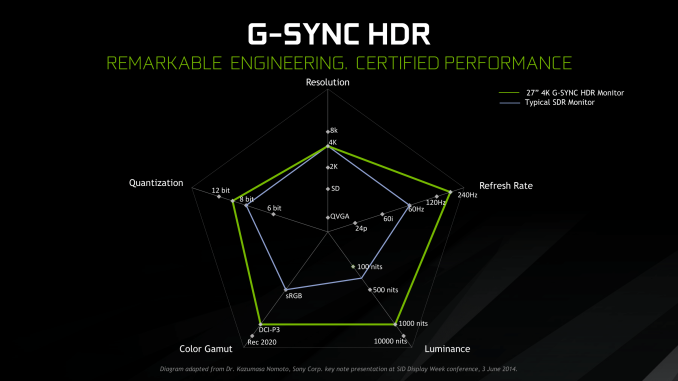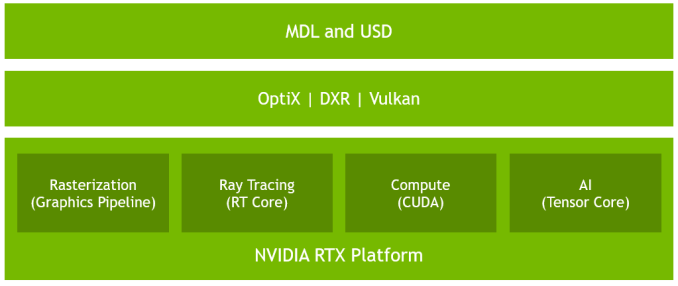The NVIDIA GeForce RTX 2080 Ti & RTX 2080 Founders Edition Review: Foundations For A Ray Traced Future
by Nate Oh on September 19, 2018 5:15 PM EST- Posted in
- GPUs
- Raytrace
- GeForce
- NVIDIA
- DirectX Raytracing
- Turing
- GeForce RTX
Meet The New Future of Gaming: Different Than The Old One
Up until last month, NVIDIA had been pushing a different, more conventional future for gaming and video cards, perhaps best exemplified by their recent launch of 27-in 4K G-Sync HDR monitors, courtesy of Asus and Acer. The specifications and display represented – and still represents – the aspired capabilities of PC gaming graphics: 4K resolution, 144 Hz refresh rate with G-Sync variable refresh, and high-quality HDR. The future was maxing out graphics settings on a game with high visual fidelity, enabling HDR, and rendering at 4K with triple-digit average framerate on a large screen. That target was not achievable by current performance, at least, certainly not by single-GPU cards. In the past, multi-GPU configurations were a stronger option provided that stuttering was not an issue, but recent years have seen both AMD and NVIDIA take a step back from CrossFireX and SLI, respectively.
Particularly with HDR, NVIDIA expressed a qualitative rather than quantitative enhancement in the gaming experience. Faster framerates and higher resolutions were more known quantities, easily demoed and with more intuitive benefits – though in the past there was the perception of 30fps as cinematic, and currently 1080p still remains stubbornly popular – where higher resolution means more possibility for details, higher even framerates meant smoother gameplay and video. Variable refresh rate technology soon followed, resolving the screen-tearing/V-Sync input lag dilemma, though again it took time to catch on to where it is now – nigh mandatory for a higher-end gaming monitor.
For gaming displays, HDR was substantively different than adding graphical details or allowing smoother gameplay and playback, because it meant a new dimension of ‘more possible colors’ and ‘brighter whites and darker blacks’ to gaming. Because HDR capability required support from the entire graphical chain, as well as high-quality HDR monitor and content to fully take advantage, it was harder to showcase. Added to the other aspects of high-end gaming graphics and pending the further development of VR, this was the future on the horizon for GPUs.
But today NVIDIA is switching gears, going to the fundamental way computer graphics are modelled in games today. Of the more realistic rendering processes, light can be emulated as rays that emit from their respective sources, but computing even a subset of the number of rays and their interactions (reflection, refraction, etc.) in a bounded space is so intensive that real time rendering was impossible. But to get the performance needed to render in real time, rasterization essentially boils down 3D objects as 2D representations to simplify the computations, significantly faking the behavior of light.
It’s on real time ray tracing that NVIDIA is staking its claim with GeForce RTX and Turing’s RT Cores. Covered more in-depth in our architecture article, NVIDIA’s real time ray tracing implementation takes all the shortcuts it can get, incorporating select real time ray tracing effects with significant denoising but keeping rasterization for everything else. Unfortunately, this hybrid rendering isn’t orthogonal to the previous concepts. Now, the ultimate experience would be hybrid rendered 4K with HDR support at high, steady, and variable framerates, though GPUs didn’t have enough performance to get to that point under traditional rasterization.
There’s a still a performance cost incurred with real time ray tracing effects, except right now only NVIDIA and developers have a clear idea of what it is. What we can say is that utilizing real time ray tracing effects in games may require sacrificing some or all three of high resolution, ultra high framerates, and HDR. HDR is limited by game support more than anything else. But the first two have arguably minimum performance standards when it comes to modern high-end gaming on PC – anything under 1080p is completely unpalatable, and anything under 30fps or more realistically 45 to 60fps hurts the playability. Variable refresh rate can mitigate the latter and framedrops are temporary, but low resolution is forever.
Ultimately, the real time ray tracing support needs to be implemented by developers via a supporting API like DXR – and many have been working hard on doing so – but currently there is no public timeline of application support for real time ray tracing, Tensor Core accelerated AI features, and Turing advanced shading. The list of games with support for Turing features - collectively called the RTX platform - will be available and updated on NVIDIA's site.













337 Comments
View All Comments
nevcairiel - Thursday, September 20, 2018 - link
Technically AMD would have to hit a 70-80% advancement at least once over their own cards at least if they ever want to offer high-end cards again.Arbie - Thursday, September 20, 2018 - link
Why gratuitously characterize all those complaining of price as "AMD fanboys"? Obviously, most are those who intended to buy the new NVidia boards but are dismayed to find them so costly! Hardly AMD disciples.Your repeated, needless digs mark you as the fanboy. And do nothing to promote your otherwise reasonable statements.
eddman - Thursday, September 20, 2018 - link
I'm such an AMD fanboy that I have a 1060 and have never owned an AMD product. You, on the other hand, reek of pro nvidia bias.A 40% higher launch MSRP is not "how it always works out".
No one is complaining about the performance itself but the horrible price/performance increase, or should I say decrease, compared to pascal.
Moore's law? 980 Ti was made on the same 28nm process as 780 Ti and yet offered considerably higher performance and still launched at a LOWER MSRP, $650 vs. $700.
Inteli - Saturday, September 22, 2018 - link
Got enough straw for that strawman you're building? The last 3 GPUs I've bought have been Nvidia (970, 1060, 1070 Ti). I would have considered a Vega 56, but the price wasn't low enough that I was willing to buy one.News flash: in current games, the 2080 is tied with the 1080 Ti for the same MSRP (and the 1080 Ti will be cheaper with the new generation launches). Sure, if you compare the 1080 to the 2080, the 2080 is significantly faster, but those only occupy the same position in Nvidia's product stack, not in the market. No consumer is going to compare a $500 card to a $700-800 card.
The issues people take with the Turing launch have absolutely nothing to do with either "We only got a 40% perf increase" or "Nvidia raised the prices" in isolation. Every single complaint I've seen is "Turing doesn't perform any better in current games as an equivalently priced Pascal card".
Lots of consumers are pragmatists, and will buy the best performing card they can afford. These are the people complaining about (or more accurately disappointed by) Turing's launch: Turing doesn't do anything for them. Sure, Nvidia increased the performance of the -80 and -80 Ti cards compared to last generation, but they increased the price as well, so price/performance is either the same or worse compared to Pascal. Many people were holding off on buying new cards until this launch, and in return for their patience they got...the same performance as before.
mapesdhs - Wednesday, September 26, 2018 - link
Where I live (UK), the 2080 is 100 UKP more expensive than a new 1080 Ti from normal retail sources, while a used 1080 Ti is even less. The 2080 is not worth it, especially with less RAM. It wouldn't have been quite so bad if the 2080 was the same speed for less cost, but being more expensive just makes it look silly. Likewise, if the 2080 Ti had had 16GB that would at least have been something to distinguish it from the 1080 Ti, but as it stands, the extra performance is meh, especially for the enormous cost (literally 100% more where I am).escksu - Thursday, September 20, 2018 - link
Lol.....most important??If you think that ray tracing on 2080ti is damm cool and game changer.....You should see what AMD has done. Just that no one really care about it back then.....
https://forums.geforce.com/default/topic/437987/th...
Even more incredible is that this was done 10yrs ago on 4870x2....REAL TIME......Yes, I repeat, REAL TIME.......
nevcairiel - Thursday, September 20, 2018 - link
It was just another "rasterization cheat" though, may have looked nice but ultimately didn't have the longevity that Ray Tracing may have. No 3D developer or 3D artist is going to ever argue that Ray Tracing is not the future, the question is just how to get there.V900 - Thursday, September 20, 2018 - link
Meh... The image itself is captured by cameras, it’s the manipulation of it that’s done in real time.Which is of course a neat little trick; and while it looks good, it’s hardly as impressive and computationally demanding as creating a whole image through raytracing.
escksu - Thursday, September 20, 2018 - link
https://www.cinemablend.com/games/DirectX-11-Ray-T...AMD did that again with 5870.... REAL TIME......but nobody cares........because the world only bothers about Nvidia.........
Chawitsch - Thursday, September 20, 2018 - link
The demos you linked to are beautiful indeed, however both the ATi Ruby demo and Rigid Gems demo use standard DirectX feature from those times, no ray tracing at all or any vendor specific features. Due to the latter it is worth pointing out that the 2008 Ruby demo (called Double Cross IIRC) was perfectly happy to run on nVidia cards of the time.If these demos show anything, it is that there were and are extremely talented artists out there who can do amazing things to work around the limitations of rasterization. This way however we can always merely approximate how a scene should look, with increasingly high costs, so going back to proper ray tracing was only a question of when its costs will approach that of rasterization. We seem to have arrived at the balancing point, hence hybrid rendering. I also think if AMD could have pushed nVidia more with high end GPUs, nVidia may not have made this step at this time, at least it certainly could have been a more risky proposition otherwise.